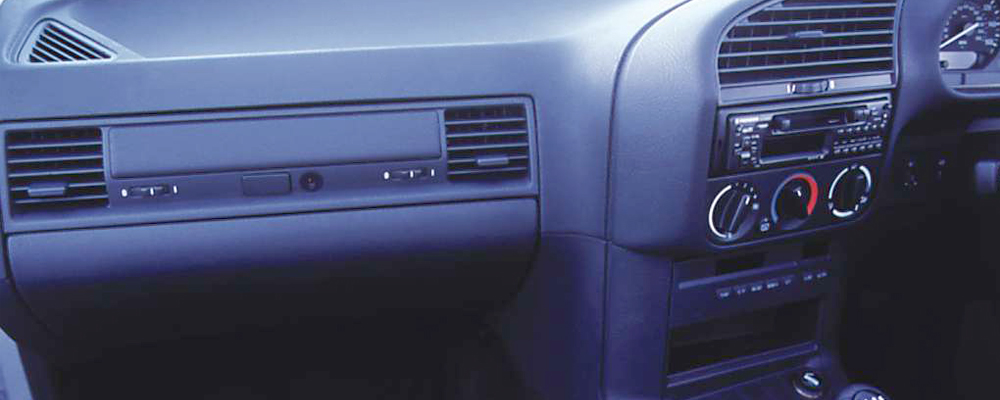
PVC in Automotives
Plastic is increasingly an integral part of modern cars. Any brand would be challenged to manufacture a modern car which doesn’t contain some plastic elements. In fact, the European Council of Vinyl Manufacturers (ECVM) estimates that around 150kg of plastics are used within an average vehicle.
The attraction of plastics
Building today’s cars requires high performing materials, which help protect occupants, produce cheaper, cleaner and more energy efficient vehicles and last the life of the car, typically 10-15 years. Plastics, including soft PVC in particular, have played a very significant role in light-weighting and improving performance and efficiency.
The British Plastics Federation has calculated that every 100kg of plastic (including PVC) can replace between 200-300 kg of traditional materials. Over the average lifespan of a vehicle, these 100kg of plastics will reduce fuel consumption by 750 litres and consequently, the CO2 emissions.
Nowadays, an average European car contains around 16 kilograms of PVC compound material, which can above all be found in car interiors, underbody protection, joint seals, door panels and cables. EFTEC, one of the world’s largest polymer components manufacturers for the automotive industry, explains the extensive use of PVC in automobiles.
“PVC is being used in many applications that users don’t often think about but which are essential to modern vehicles’ comfort and performance, as well as optimising the car body by reducing weight. For example, layers of flexible vinyl are used for stonechip-protection, sound damping, as sealants, as well as in protective coatings to cover widely exposed areas such as underbodies, wheel arches and rocker panels.
“Automobiles can last much longer and that is, in part, due to the use of this type of flexible PVC which helps to minimise the effects of weather, road and driving conditions.”
Back in the 1990s, a number of car-makers announced moves to distance themselves from PVC use, often because of perceptions of recycling difficulties. However, after more than a decade of exploring alternatives, many manufacturers have realised that replacing PVC may led to inferior performance and higher costs.
Typical PVC automotive components found in use today include instrument panels and associated mouldings, sun visors, synthetic leather seat coverings, headlinings, seals, mud flaps, noise and vibration reduction components, floor coverings, exterior side moulding and protective strips.
PVC's attributes for automotive applications include:
- Controlled oxygen and water vapour transmission.
- Affordable.
- Soft and scratch resistant skins for dashboards.
- Cold temperature resistance.
- UV stability.
- Durability.
- Light weight.
Light weight
PVC compounds used in vehicles offer excellent cost-performance advantages. A recent study by the independent industrial services consultancy Mavel Consultants, demonstrated the cost of using alternative materials to PVC would be in the range of 20-100% higher per component.
Recyclable PVC
Recycling is an important aspect for end-of-life vehicles. Previously, concerns have been raised about the feasibility of recycling PVC from end-of-life vehicles. However, according to Autovinyle’s data, decomposition trials done by R&D specialists at INDRA confirmed that about 30% of PVC can be economically recovered for recycling, mainly from flexible PVC parts found in interiors.
Other benefits of PVC in cars include:
- Longevity of service - The average service life of a modern car is 17 years in contrast to 11 years in the 1970s, thanks in part to the use of PVC. In terms of disposal, most plastics including PVC can be recycled, however, recycling cling wrap after it has been in contact with food is difficult.
- Low carbon footprint - PVC has a natural low carbon footprint, and when coupled with the advantage of the lightness of PVC components in comparison to traditional materials, this results in reduced energy consumption and a lower carbon footprint for vehicles.
- Safety first - PVC is important in shock-absorbing vehicle components such as 'soft' dashboards, reducing injury in the case of impact.
- Increased design freedom - PVC can be made to give many attractive qualities of appearance and leather-like softness. Vinyl vehicle wrap is increasingly popular to ‘dress’ cars in enticing designs and advertising, and the wrap can be recycled after removal.
- Reduced noise for vehicle occupants - The sound-dampening properties of PVC cuts down noise inside the car.





